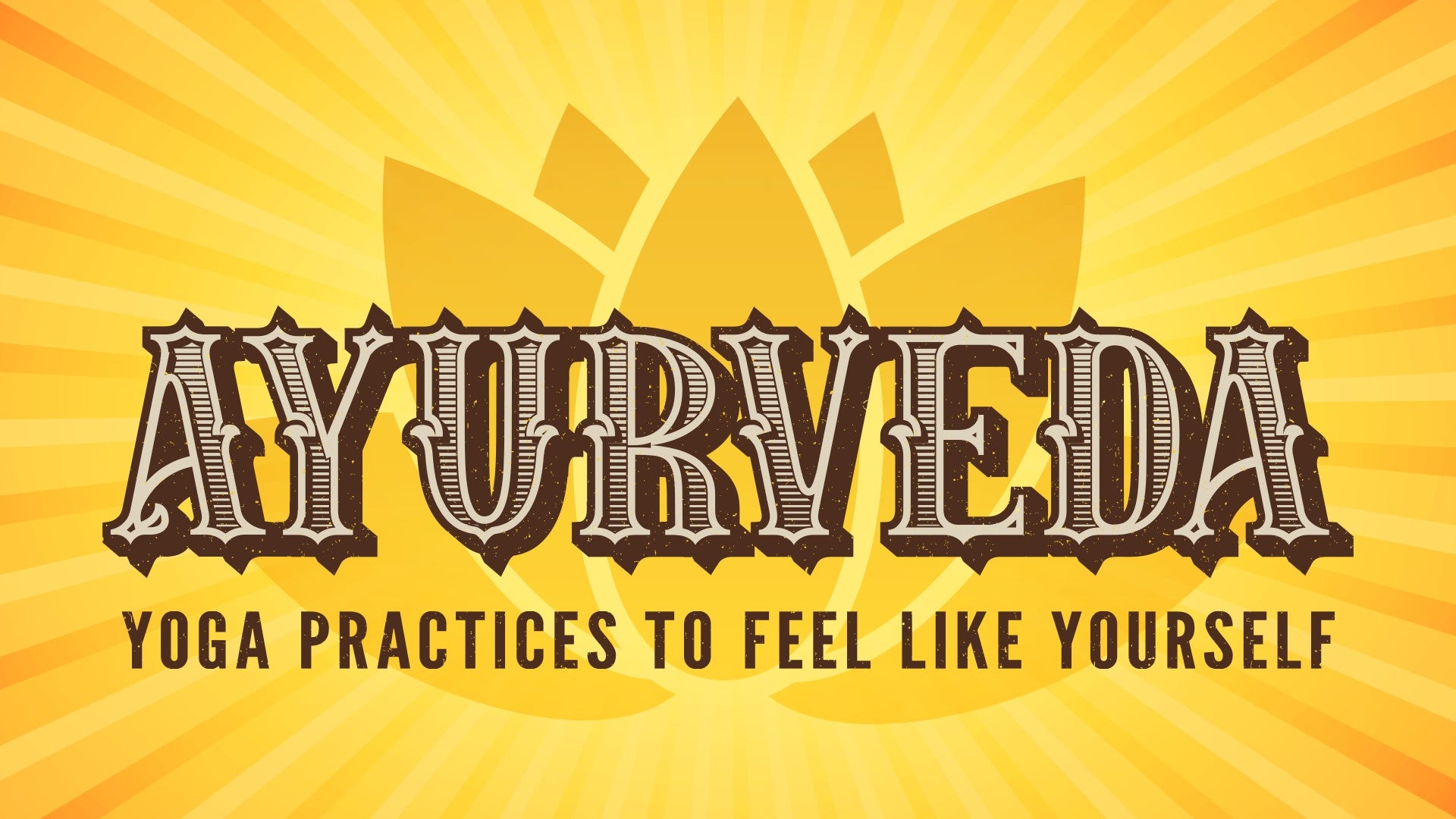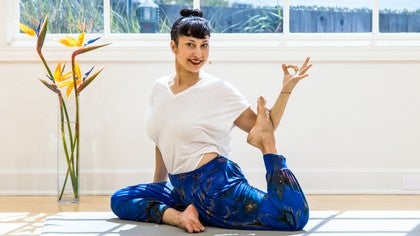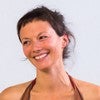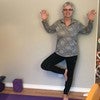Description
About This Video
Transcript
Read Full Transcript
Namaste. For today's practice, we're going to start off in an easy seat. Start in your sukhasana and rub your palms together for a moment. Rub, rub, rub. I often like to start my practice off with a mudra. It's just a very subtle way of bringing in an intention into practice. So bring the pinky fingers and the thumbs together and let the rest of the fingers open up wide. And this is lotus mudra and it connects us to our heart. So let your eyes close here for a moment and sit with your mudra. And there's a reason why you see the lotus in so many, as a symbol in so many spiritual practices. That its roots go down deep. It rises up out of the mud towards the light. So have a moment here. You with your breath, your fingers nice and wide and spread, let your shoulders drop down. And mudra even means to bring joy. So pressing the fingers together, feeling the heels of the hands. And if there's an intention that you like to set for your practice, you could set one here. But sometimes movement can be so healing and so can stillness. Especially if you've been having a day where you're running around a lot, just to stop and sit and breathe. And still evoke a mood or an intention. Last couple of breaths with this. And then go ahead and release your mudra. Turn your palms upright on your thighs for a moment. And then if you're sitting on a blanket or a block, you can slide that off to the side. Place your hands down and we're going to come into a downward facing dog. And I love starting my practice off with down dog. It's just a way of feeling the strength of arms and legs underneath us. It's also a gentle inversion. So sometimes just to start to look at the world slightly differently, to change our perspective. And physiologically, it actually speeds the blood to the heart. And that can make us feel better. It gets more oxygenated, travels through the body. And then you're going to lift the right leg up. And step right forward into pigeon pose. So bring the right shin forward. And you can set that up with blocks or blankets if you need. Have a moment on your fingertips and lift up out of your hips. And then if you want the back bend here, you can bend the left knee and reach back for your left ankle or foot with your left hand just to get the thigh stretch. If that feels like too much right now, let it go. And just walk your hands forward and come into an easy forward bend. And generally with the forward bend and pigeon, we can move the right foot a little bit forward more out in front of you. But if that's too much for your knees or your hips, then let it go. And once you've come forward, hands could come into a prayer. And just remembering to breathe all the way around the circumference of the waist. Slide your hands back underneath your shoulders. Push yourself up to sit. From here, you're going to bring the left leg around in front of you and come to an easy cross-legged seat. Your left leg can be right in front of your right one. And walk your hands forward. You're in cross-legged seat, coming forward, letting the head drop. Again, neck is soft. Even let the muscles of the face go. And then walk your hands back up. Keep your right leg where it is and open your left leg out as wide as you can to the left. And you might slide your right heel in a little bit closer to you. A strong flex in your left foot. Take a little bit of a twist towards your right leg. Left hand to the outside of the right side. Reach your right arm up. And then a big side bend. So we're coming into what's called Parsva Janusasasana. And as you do that, I'm pressing down into the tops of my right toes a bit. And that helps to anchor my right hip. From there, bring the right side of your waist forward. We're coming into regular Janusasasana. So your left hand can come to the outside of your left leg. Right hand on the other side. Let your head drop in. And if you'd like, you can reach for the ankle or the heel and fold forward. Take it a little bit deeper. But I like to keep the right leg wide for this one and get that reach across the side waist. Feels good. Come on back up. And bring your left foot to meet your right so you're in a Baddha Konasana shape with the legs. But we're not going to stay there. For this one, just a moment to lift the chest, drop the thighs. And then bring your knees in towards each other. Step your feet to the ground. And stretch your legs out long in front of you coming into Dandasana. So hands by the hips, flexing the feet. Roll the shoulders back, head lifted. Pressing down into the centers of the thighs.
And then slide your feet back about hip width apart, hands back behind you, fingers pointing towards your heels. Press your body up and we're coming into what I call alter pose. It's like a reverse tabletop. Take a full breath in right there and then open your mouth and anything you need to let go of, just let it go. Release your seat back down, cross your right ankle in front of your left, come back into your hands and knees, shape, tuck your toes under, downward facing dog. And then reach your left leg up and bring your left shin through for a pigeon pose. And again, setting yourself up, blanket, blocks, if you need it, walk the fingertips back. And lifting up out of the shape for a moment, just so you can check in some length in the spine. And then if you took the back bend variation, reaching back, holding onto the right foot, the right ankle, drawing it in for the thigh stretch. And then when you've had enough of that, you can walk the hands forward. Those of you who already came into a forward bend, perfect. You might put a little extra emphasis on the exhale here, just to really get a sense of letting go. There's so many big muscles around the hips. So just taking a little bit more time here to drop in. Let the opening happen gently. And then walk your hands underneath your shoulders and press yourself up to sit. Left leg stays where it is, right leg comes around, crossing it in front of the left. And then walk your hands forward and take your forward bend. And if you need a big sigh on any of these forward bends, go for it. Anything just to emphasize that feeling of opening up, letting go, dropping in. And then take your hands under your shoulders, roll yourself back up. Keep your left leg where it is this time and stretch your right leg out to the right. Again, you can draw the left heel in a little bit closer to protect the knee. Take a little bit of a twist over to your left. Stretch your left arm up and then side bend over to the right. And reach all the way around the left side. And you can even use the bottom hand to twist a little bit more and get some space between the crest of the hip and the bottom of the ribs. Reaching over. Turning to face your right leg, coming into your jhanushasasana. Let your head fall. And feel it out. If today is a day to reach for the foot, you'll reach for the foot. Otherwise the hands can be on the ground or around the ankle. Folding in. Come on back up. One more time. Soles the feet together. Knees open. Baddha konasana shape. Draw the knees in towards each other. And stretch your legs out long, coming back into your dandasana. Shape the feet here. Draw back on the pinky side of the foot. Press the big toe side away from you. Nice long spine. Open across the chest. And then folding forward into your pashimo tenasana. And let your head drop.
And if you need more room in the lower back or the hamstrings, you can bend the knees. You can also put a blanket underneath your knees. The forward folds, we stay a little bit longer. And they can be so lovely and cooling and calming at the end of a day. Or even on a break in your day. If you need to just quiet down a little. And then roll yourself back up. One more time. Hands back behind you. Soles the feet to the ground. A little bit wider than your hips. Pressing up. Full breath in. Open your mouth. Breathe it out. And release your sit bones back down. And we're going to set up for a restorative upavishta. So bolster if you've got it in a blanket. If you do not have a bolster, no worries. You can grab a couple of pillows off your couch or roll up some towels. Use anything you have. Just so you can give yourself a little bit of support for your chest and your belly. And then you're just going to come forward. And some people like their forehead straight down. Some people like to turn their head to the side. I like the forehead straight down just to keep my neck a little bit more aligned. So I'm actually going to take this up a little bit higher for me. And drop right in. It's nice to remember. I'm going to bring my head up for this one. It's nice to remember to not take a restorative to the full range of your movement. It's actually better for your body if you stop before you feel stretching.
This is more of a letting go. So the forehead comes down. The arms release. Another little detail that I can offer here is elbows underneath the shoulders. Let your forearms rest. If you're having trouble getting your arms to the ground, you're probably up too high. Or you need to bring the floor up to you and put something underneath your elbows. But there shouldn't be any dangling limbs. And then you can just stay here. And at a certain point you might even let the legs soften. You don't have to flex your feet or point your feet. You can just let them do whatever they want here. The restorative poses can be such a good reset. If you've had a day where you just need to step away from your life for a moment and you've got even five minutes, it can make such a difference. When you're ready to come out of it, and if you need to stay, stay longer. You can always pause the sequence and just stay a few minutes longer. If you're ready to come up, coming up slowly. And just take a moment. Once you're upright, just to breathe. And our last shape is going to be a restorative fish pose. So again, I'm using my bolster for this. But if you do not have a bolster, you can use anything around a house that gives you a little bit more cushioning. Taking my blanket, like it's in fourths, and just fold it one more time. And then this is a little fun trick. A lot of times you'll see that the smooth end is right behind the head for today. Take the rough end around the head. And it's going to go right behind my head, right at the line of my shoulders and my head. And then you can take the rough end and roll it underneath and create almost like a little cradle for your neck. And that feels really nice. So I'm taking the blanket all the way to the back of my bolster. And then I'm lying back in my restorative fish. And I can take my blanket and slide the corners underneath just to build a little cradle for my head. And my arms come out to the sides. Oh my God, it feels so amazing. Let your chest open.
A nice big exhale could be beautiful here. And just drop in. Let your belly soften. And even the muscles of the face can get a little slack here. And make sure to set yourself up well. Take the time to really set it up so that when you lay back you feel even. There's no sense of any little nagging lumps or bumps in your setup that will distract you. You can pause the sequence here if you'd like to stay a little bit longer. Otherwise make some small movements with your fingers, with your toes. Walk your feet in. Carefully rolling over onto your right side. And then use the arms to make your way up to sit. And you can slide your props off to the side. Have a seat on your bolster. And we're going to close today with a little bit of a pranayama exercise. And there's two different ways of doing this one. You can do what's called shitali, which is curling your tongue and sticking it through your lips almost like a straw. I can't show you that one because I can't do it. But I can do shikari, which is the option for those of us who cannot curl our tongues. And you'll just roll the tongue back underneath your teeth like this. And breathe in through an open mouth and then close your mouth and exhale out of your nose. So if you can curl your tongue, go ahead and curl your tongue and stick it through your lips so that it's out of your mouth and breathe in over your curled tongue. Those of those of us who can't roll the tongue back, close your mouth and exhale out of your nose. And we're going to do that five times. Inhaling. And exhaling. And inhaling. And exhaling. And inhaling. And exhaling. And inhaling. And exhaling. Pranayama is also a really lovely way to ease your way into a seated meditation practice. So if you have one of those and you'd like to sit for a few moments, you could do that. And this is where our practice will close. Thank you so much for joining me. Namaste.
Ayurveda: Practices to Feel Like Yourself
Comments
You need to be a subscriber to post a comment.
Please Log In or Create an Account to start your free trial.


















